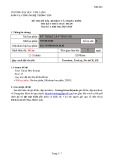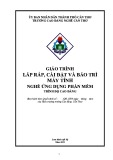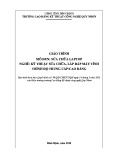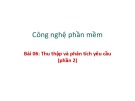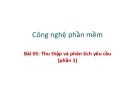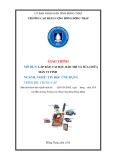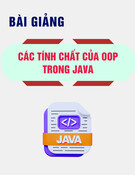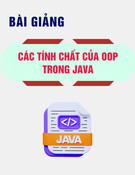2/25/2016
Topics covered
Functional and non-functional requirements
The software requirements document
Chapter 3 – Requirements Engineering
Requirements specification
Requirements engineering processes
Requirements elicitation and analysis
Lecture 1
Requirements validation
Requirements management
1
Chapter3 Requirements engineering
2
Chapter3 Requirements engineering
Requirements engineering Readers of different types of requirements specification
User requirements System requirements
Chapter3 Requirements engineering
3
Chapter3 Requirements engineering
4
Requirements engineering What is a requirement? Types of requirement
Functional and non-functional requirements Functional requirements
Chapter3 Requirements engineering
5
Chapter3 Requirements engineering
6
Describe functionality or system services. Functional requirements Depend on the type of software, expected users and the Non-functional requirements type of system where the software is used. Domain requirements Functional user requirements may be high-level statements of what the system should do. Functional system requirements should describe the system services in detail.
1
2/25/2016
Requirements imprecision
Requirements completeness and consistency
Problems arise when requirements are not precisely
In principle, requirements should be both complete and
stated.
consistent.
Ambiguous requirements may be interpreted in different
Complete Consistent
ways by developers and users.
In practice, it is impossible to produce a complete and
Consider the term ‘search’ in requirement 1
consistent requirements document.
User intention – search for a patient name across all
appointments in all clinics;
Developer interpretation – search for a patient name in an
individual clinic. User chooses clinic then search.
Chapter3 Requirements engineering
7
Chapter3 Requirements engineering
8
Non-functional requirements Types of nonfunctional requirement
These define system properties and constraints
Process requirements may also be specified mandating a particular IDE, programming language or development method. Non-functional requirements may be more critical than
Chapter3 Requirements engineering
9
Chapter3 Requirements engineering
10
functional requirements. If these are not met, the system may be useless.
Non-functional requirements implementation Non-functional classifications
For example, to ensure that performance requirements are met,
you may have to organize the system to minimize communications between components.
Product requirements Organisational requirements Non-functional requirements may affect the overall architecture of a system rather than the individual components. External requirements
A single non-functional requirement, such as a security
It may also generate requirements that restrict existing
requirements.
Chapter3 Requirements engineering
11
Chapter3 Requirements engineering
12
requirement, may generate a number of related functional requirements that define system services that are required.
2
2/25/2016
Goals and requirements
Metrics for specifying nonfunctional requirements
Property
Measure
Speed
Non-functional requirements may be very difficult to state precisely and imprecise requirements may be difficult to verify.
Processed transactions/second User/event response time Screen refresh time
Size
Goal
Mbytes Number of ROM chips
Ease of use
A general intention of the user such as ease of use.
Training time Number of help frames
Verifiable non-functional requirement
Reliability
A statement using some measure that can be objectively tested.
Mean time to failure Probability of unavailability Rate of failure occurrence Availability
Goals are helpful to developers as they convey the
Robustness
intentions of the system users.
Time to restart after failure Percentage of events causing failure Probability of data corruption on failure
Portability
Percentage of target dependent statements Number of target systems
Chapter3 Requirements engineering
13
Chapter3 Requirements engineering
14
Domain requirements Domain requirements problems
For example, a train control system has to take into account the
braking characteristics in different weather conditions.
The system’s operational domain imposes requirements Understandability on the system. Implicitness
Chapter3 Requirements engineering
15
Chapter3 Requirements engineering
16
Domain requirements be new functional requirements, constraints on existing requirements or define specific computations. If domain requirements are not satisfied, the system may be unworkable.
The software requirements document
The software requirements document is the official statement of what is required of the system developers. Should include both a definition of user requirements Chapter 4 – Requirements Engineering and a specification of the system requirements. It is NOT a design document. As far as possible, it
Lecture 2
17
Chapter3 Requirements engineering
18
Chapter3 Requirements engineering
should set of WHAT the system should do rather than HOW it should do it.
3
2/25/2016
Users of a requirements document
Requirements document variability
Information in requirements document depends on type
of system and the approach to development used.
Systems developed incrementally will, typically, have
less detail in the requirements document.
Requirements documents standards have been designed e.g. IEEE standard. These are mostly applicable to the requirements for large systems engineering projects.
Chapter3 Requirements engineering
19
Chapter3 Requirements engineering
20
The structure of a requirements document Requirements specification
The process of writing don the user and system
Chapter
1. Preface
6. System requirements specification
2. Introduction
7. System models
requirements in a requirements document.
3. Glossary
8. System evolution
4. User requirements definition 9. Appendices
5. System architecture
10. Index
It is therefore important that these are as complete as possible.
Chapter3 Requirements engineering
21
Chapter3 Requirements engineering
22
User requirements have to be understandable by end- users and customers who do not have a technical background. System requirements are more detailed requirements and may include more technical information. The requirements may be part of a contract for the system development
Requirements and design Ways of writing a system requirements specification
Notation
Natural language
Structured natural language
Design description languages
In principle, requirements should state what the system should do and the design should describe how it does this.
requirements;
Graphical notations
The system may inter-operate with other systems that generate
design requirements;
Mathematical specifications
The use of a specific architecture to satisfy non-functional
requirements may be a domain requirement.
This may be the consequence of a regulatory requirement.
Chapter3 Requirements engineering
23
In practice, requirements and design are inseparable A system architecture may be designed to structure the
4
2/25/2016
Guidelines for writing requirements
Natural language specification
Requirements are written as natural language sentences
Invent a standard format and use it for all requirements.
supplemented by diagrams and tables.
Used for writing requirements because it is expressive,
Use language in a consistent way. Use shall for mandatory requirements, should for desirable requirements.
intuitive and universal. This means that the requirements can be understood by users and customers.
Use text highlighting to identify key parts of the
requirement.
Avoid the use of computer jargon.
Include an explanation (rationale) of why a requirement
is necessary.
Chapter3 Requirements engineering
25
Problems with natural language Example requirements for the insulin pump software system
Precision is difficult without making the document difficult to
read.
Lack of clarity
Functional and non-functional requirements tend to be mixed-up.
Requirements confusion
Several different requirements may be expressed together.
Requirements amalgamation
3.2 The system shall measure the blood sugar and deliver insulin, if required, every 10 minutes. (Changes in blood sugar are relatively slow so more frequent measurement is unnecessary; less frequent measurement could lead to unnecessarily high sugar levels.) 3.6 The system shall run a self-test routine every minute with the conditions to be tested and the associated actions defined in Table 1. (A self-test routine can discover hardware and software problems and alert the user to the fact the normal operation may be impossible.)
Chapter3 Requirements engineering
28
Structured specifications Form-based specifications
Chapter3 Requirements engineering
29
Definition of the function or entity. Description of inputs and where they come from. An approach to writing requirements where the freedom of the requirements writer is limited and requirements are written in a standard way. Description of outputs and where they go to. Information about the information needed for the computation and other entities used. This works well for some types of requirements e.g. requirements for embedded control system but is sometimes too rigid for writing business system requirements. Description of the action to be taken. Pre and post conditions (if appropriate). The side effects (if any) of the function.
5
2/25/2016
A structured specification of a requirement for an insulin pump
A structured specification of a requirement for an insulin pump
Chapter3 Requirements engineering
31
Chapter3 Requirements engineering
32
Tabular specification Tabular specification of computation for an insulin pump
Used to supplement natural language.
Condition
Action
Sugar level falling (r2 < r1)
CompDose = 0
Sugar level stable (r2 = r1)
CompDose = 0
level
CompDose = 0
increasing and rate of decreasing
Sugar increase ((r2 – r1) < (r1 – r0))
level
=
Particularly useful when you have to define a number of possible alternative courses of action. For example, the insulin pump systems bases its
increasing and rate of increasing
or
Sugar increase stable ((r2 – r1) ≥ (r1 – r0))
=
CompDose round ((r2 – r1)/4) If rounded result = 0 then CompDose MinimumDose
Chapter3 Requirements engineering
34
computations on the rate of change of blood sugar level and the tabular specification explains how to calculate the insulin requirement for different scenarios.
Requirements engineering processes A spiral view of the requirements engineering process
The processes used for RE vary widely depending on the application domain, the people involved and the organisation developing the requirements. However, there are a number of generic activities
Chapter3 Requirements engineering
35
Chapter3 Requirements engineering
36
common to all processes Requirements elicitation; Requirements analysis; Requirements validation; Requirements management. In practice, RE is an iterative activity in which these processes are interleaved.
6
2/25/2016
Problems of requirements analysis
Requirements elicitation and analysis
Sometimes called requirements elicitation or
Stakeholders don’t know what they really want.
requirements discovery.
Stakeholders express requirements in their own terms.
Different stakeholders may have conflicting
requirements.
Organisational and political factors may influence the
Involves technical staff working with customers to find out about the application domain, the services that the system should provide and the system’s operational constraints.
system requirements.
The requirements change during the analysis process.
May involve end-users, managers, engineers involved in maintenance, domain experts, trade unions, etc. These are called stakeholders.
New stakeholders may emerge and the business environment may change.
Chapter3 Requirements engineering
37
Chapter3 Requirements engineering
38
Requirements elicitation and analysis The requirements elicitation and analysis process
Software engineers work with a range of system
Requirements discovery,
Requirements classification and organization, Requirements prioritization and negotiation,
Requirements specification.
Chapter3 Requirements engineering
39
Chapter3 Requirements engineering
40
stakeholders to find out about the application domain, the services that the system should provide, the required system performance, hardware constraints, other systems, etc. Stages include:
Process activities
Requirements discovery Requirements classification and organisation Prioritisation and negotiation Chapter 4 – Requirements Engineering Requirements specification
Lecture 3
Chapter3 Requirements engineering
42
7
2/25/2016
Requirements discovery
Stakeholders in the MHC-PMS
Patients whose information is recorded in the system.
Doctors who are responsible for assessing and treating
The process of gathering information about the required and existing systems and distilling the user and system requirements from this information.
patients.
Interaction is with system stakeholders from managers to
Nurses who coordinate the consultations with doctors
external regulators.
and administer some treatments.
Systems normally have a range of stakeholders.
Medical receptionists who manage patients’
appointments.
IT staff who are responsible for installing and maintaining
the system.
Chapter3 Requirements engineering
43
Chapter3 Requirements engineering
44
Stakeholders in the MHC-PMS Interviewing
Closed interviews based on pre-determined list of questions Open interviews where various issues are explored with
stakeholders.
A medical ethics manager who must ensure that the Formal or informal interviews with stakeholders are part system meets current ethical guidelines for patient care. of most RE processes. Health care managers who obtain management Types of interview information from the system. Medical records staff who are responsible for ensuring
Be open-minded, avoid pre-conceived ideas about the requirements and are willing to listen to stakeholders.
Prompt the interviewee to get discussions going using a
springboard question, a requirements proposal, or by working together on a prototype system.
Chapter3 Requirements engineering
45
Chapter3 Requirements engineering
46
Effective interviewing that system information can be maintained and preserved, and that record keeping procedures have been properly implemented.
Interviews in practice Scenarios
A description of the starting situation; A description of the normal flow of events;
Normally a mix of closed and open-ended interviewing. Scenarios are real-life examples of how a system can be used. Interviews are good for getting an overall understanding They should include of what stakeholders do and how they might interact with the system. Interviews are not good for understanding domain
A description of what can go wrong; Information about other concurrent activities;
terminology;
A description of the state when the scenario finishes.
Some domain knowledge is so familiar that people find it hard to
articulate or think that it isn’t worth articulating.
requirements Requirements engineers cannot understand specific domain
8
2/25/2016
Scenario for collecting medical history in MHC- PMS
Scenario for collecting medical history in MHC- PMS
Chapter3 Requirements engineering
49
Chapter3 Requirements engineering
50
Use cases Use cases for the MHC-PMS
Use-cases are a scenario based technique in the UML which identify the actors in an interaction and which describe the interaction itself. A set of use cases should describe all possible interactions with the system. High-level graphical model supplemented by more detailed tabular description (see Chapter 5). Sequence diagrams may be used to add detail to use-
Chapter3 Requirements engineering
51
Chapter3 Requirements engineering
52
cases by showing the sequence of event processing in the system.
Requirements validation Requirements checking
Fixing a requirements error after delivery may cost up to 100
times the cost of fixing an implementation error.
Chapter3 Requirements engineering
53
Chapter3 Requirements engineering
54
Validity. Does the system provide the functions which Concerned with demonstrating that the requirements define the system that the customer really wants. best support the customer’s needs? Requirements error costs are high so validation is very Consistency. Are there any requirements conflicts? important Completeness. Are all functions required by the customer included? Realism. Can the requirements be implemented given available budget and technology Verifiability. Can the requirements be checked?
9
2/25/2016
Requirements validation techniques
Requirements reviews
Requirements reviews
Regular reviews should be held while the requirements
Systematic manual analysis of the requirements.
definition is being formulated.
Prototyping
Both client and contractor staff should be involved in
Using an executable model of the system to check requirements.
reviews.
Covered in Chapter 2. Test-case generation
Developing tests for requirements to check testability.
Reviews may be formal (with completed documents) or informal. Good communications between developers, customers and users can resolve problems at an early stage.
Chapter3 Requirements engineering
55
Chapter3 Requirements engineering
56
Review checks Requirements management
Is the requirement realistically testable?
Verifiability Requirements management is the process of managing
Is the requirement properly understood?
Is the origin of the requirement clearly stated?
Can the requirement be changed without a large impact on other
requirements?
changing requirements during the requirements engineering process and system development. Comprehensibility New requirements emerge as a system is being developed and after it has gone into use. Traceability You need to keep track of individual requirements and Adaptability
Chapter3 Requirements engineering
57
Chapter3 Requirements engineering
58
maintain links between dependent requirements so that you can assess the impact of requirements changes. You need to establish a formal process for making change proposals and linking these to system requirements.
Changing requirements Changing requirements
New hardware may be introduced, it may be necessary to
The final system requirements are inevitably a compromise
interface the system with other systems, business priorities may change (with consequent changes in the system support required), and new legislation and regulations may be introduced that the system must necessarily abide by.
between them and, with experience, it is often discovered that the balance of support given to different users has to be changed.
The business and technical environment of the system always changes after installation. Large systems usually have a diverse user community, with many users having different requirements and priorities that may be conflicting or contradictory.
System customers impose requirements because of
organizational and budgetary constraints. These may conflict with end-user requirements and, after delivery, new features may have to be added for user support if the system is to meet its goals.
Chapter3 Requirements engineering
59
Chapter3 Requirements engineering
60
The people who pay for a system and the users of that system are rarely the same people.
10
2/25/2016
Requirements evolution
Requirements management planning
Establishes the level of requirements management detail
that is required.
Requirements management decisions:
Requirements identification Each requirement must be uniquely
identified so that it can be cross-referenced with other requirements.
A change management process This is the set of activities that
assess the impact and cost of changes. I discuss this process in more detail in the following section.
Traceability policies These policies define the relationships between each requirement and between the requirements and the system design that should be recorded.
Tool support Tools that may be used range from specialist
requirements management systems to spreadsheets and simple database systems.
Chapter3 Requirements engineering
62
Chapter3 Requirements engineering
61
Requirements change management Requirements change management
Problem analysis and change specification
• During this stage, the problem or the change proposal is analyzed to check that it is valid. This analysis is fed back to the change requestor who may respond with a more specific requirements change proposal, or decide to withdraw the request.
Change analysis and costing
• The effect of the proposed change is assessed using traceability information and general knowledge of the system requirements. Once this analysis is completed, a decision is made whether or not to proceed with the requirements change.
Change implementation
• The requirements document and, where necessary, the system design and implementation, are modified. Ideally, the document should be organized so that changes can be easily implemented.
Chapter3 Requirements engineering
63
Chapter3 Requirements engineering
64
Deciding if a requirements change should be accepted
A POS (Point-Of-Sale) system is a computer system typically used to manage the sales in retail stores. It includes hardware components such as a computer, a bar code scanner, a printer and also software to manage the operation of the store.
The most basic function of a POS system is to handle sales. When a customer arrives at a POS counter with goods to purchase, the cashier will start a new sale transaction. When the barcode of a good is read by the POS system, it will retrieve the name and price of this good from the backend catalog system and interact with inventory system to deduce the stock amount of this good. When the sale transaction is over, the customer can pay in cash, credit card or even check. After the payment is successful, a receipt will be printed. Note that for promotion, the store frequently issue gift coupons. The customer can use the coupons for a better price when purchasing goods.
Another function of a POS system is to handle returns…
Chapter3 Requirements engineering
A user must log in to use the POS. The users of a POS system are the employees of the store including cashiers and the administrator. The administrator can access the system management functions of the POS system 65 including user management and security configuration that cashiers can’t do.
Group exercise



